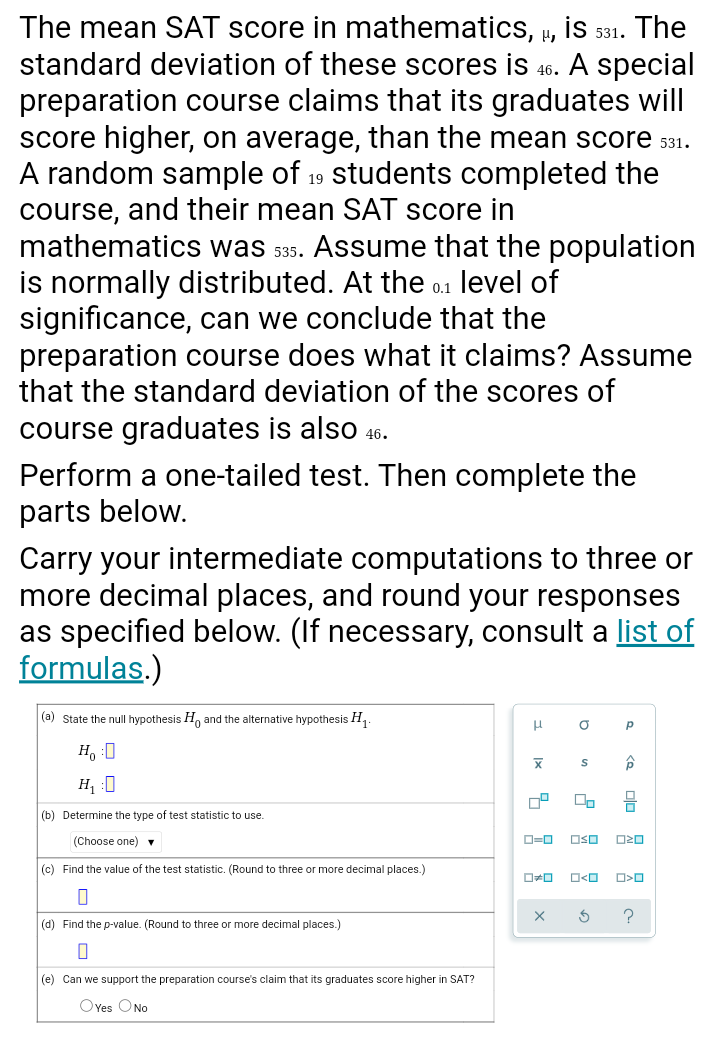The mean SAT score in mathematics, µ, İS 531. The standard deviation of these scores is 46. A special preparation course claims that its graduates will score higher, on average, than the mean score 531. A random sample of 19 students completed the course, and their mean SAT score in mathematics was s35. Assume that the population is normally distributed. At the 0.1 level of significance, can we conclude that the preparation course does what it claims? Assume that the standard deviation of the scores of course graduates is also 46. Perform a one-tailed test. Then complete the parts below. Carry your intermediate computations to three or more decimal places, and round your responses as specified below. (If necessary, consult a list of formulas.) |(a) State the null hypothesis H, and the alternative hypothesis H, H, :0 H, :0 믐 (b) Determine the type of test statistic to use. (Choose one) v O=0 OSO (c) Find the value of the test statistic. (Round to three or more decimal places.) (d) Find the p-value. (Round to three or more decimal places.) (e) Can we support the preparation course's claim that its graduates score higher in SAT? OYes ONo
The mean SAT score in mathematics, µ, İS 531. The standard deviation of these scores is 46. A special preparation course claims that its graduates will score higher, on average, than the mean score 531. A random sample of 19 students completed the course, and their mean SAT score in mathematics was s35. Assume that the population is normally distributed. At the 0.1 level of significance, can we conclude that the preparation course does what it claims? Assume that the standard deviation of the scores of course graduates is also 46. Perform a one-tailed test. Then complete the parts below. Carry your intermediate computations to three or more decimal places, and round your responses as specified below. (If necessary, consult a list of formulas.) |(a) State the null hypothesis H, and the alternative hypothesis H, H, :0 H, :0 믐 (b) Determine the type of test statistic to use. (Choose one) v O=0 OSO (c) Find the value of the test statistic. (Round to three or more decimal places.) (d) Find the p-value. (Round to three or more decimal places.) (e) Can we support the preparation course's claim that its graduates score higher in SAT? OYes ONo
MATLAB: An Introduction with Applications
6th Edition
ISBN:9781119256830
Author:Amos Gilat
Publisher:Amos Gilat
Chapter1: Starting With Matlab
Section: Chapter Questions
Problem 1P
Related questions
Question
Please see the attached photo

Transcribed Image Text:The mean SAT score in mathematics, µ, İS 531. The
standard deviation of these scores is 46. A special
preparation course claims that its graduates will
score higher, on average, than the mean score 531.
A random sample of 19 students completed the
course, and their mean SAT score in
mathematics was s35. Assume that the population
is normally distributed. At the 0.1 level of
significance, can we conclude that the
preparation course does what it claims? Assume
that the standard deviation of the scores of
course graduates is also 46.
Perform a one-tailed test. Then complete the
parts below.
Carry your intermediate computations to three or
more decimal places, and round your responses
as specified below. (If necessary, consult a list of
formulas.)
|(a) State the null hypothesis H, and the alternative hypothesis H,
H, :0
H, :0
믐
(b) Determine the type of test statistic to use.
(Choose one) v
O=0
OSO
(c) Find the value of the test statistic. (Round to three or more decimal places.)
(d) Find the p-value. (Round to three or more decimal places.)
(e) Can we support the preparation course's claim that its graduates score higher in SAT?
OYes ONo
Expert Solution
This question has been solved!
Explore an expertly crafted, step-by-step solution for a thorough understanding of key concepts.
Step by step
Solved in 2 steps with 2 images

Knowledge Booster
Learn more about
Need a deep-dive on the concept behind this application? Look no further. Learn more about this topic, statistics and related others by exploring similar questions and additional content below.Recommended textbooks for you

MATLAB: An Introduction with Applications
Statistics
ISBN:
9781119256830
Author:
Amos Gilat
Publisher:
John Wiley & Sons Inc

Probability and Statistics for Engineering and th…
Statistics
ISBN:
9781305251809
Author:
Jay L. Devore
Publisher:
Cengage Learning

Statistics for The Behavioral Sciences (MindTap C…
Statistics
ISBN:
9781305504912
Author:
Frederick J Gravetter, Larry B. Wallnau
Publisher:
Cengage Learning

MATLAB: An Introduction with Applications
Statistics
ISBN:
9781119256830
Author:
Amos Gilat
Publisher:
John Wiley & Sons Inc

Probability and Statistics for Engineering and th…
Statistics
ISBN:
9781305251809
Author:
Jay L. Devore
Publisher:
Cengage Learning

Statistics for The Behavioral Sciences (MindTap C…
Statistics
ISBN:
9781305504912
Author:
Frederick J Gravetter, Larry B. Wallnau
Publisher:
Cengage Learning

Elementary Statistics: Picturing the World (7th E…
Statistics
ISBN:
9780134683416
Author:
Ron Larson, Betsy Farber
Publisher:
PEARSON

The Basic Practice of Statistics
Statistics
ISBN:
9781319042578
Author:
David S. Moore, William I. Notz, Michael A. Fligner
Publisher:
W. H. Freeman

Introduction to the Practice of Statistics
Statistics
ISBN:
9781319013387
Author:
David S. Moore, George P. McCabe, Bruce A. Craig
Publisher:
W. H. Freeman